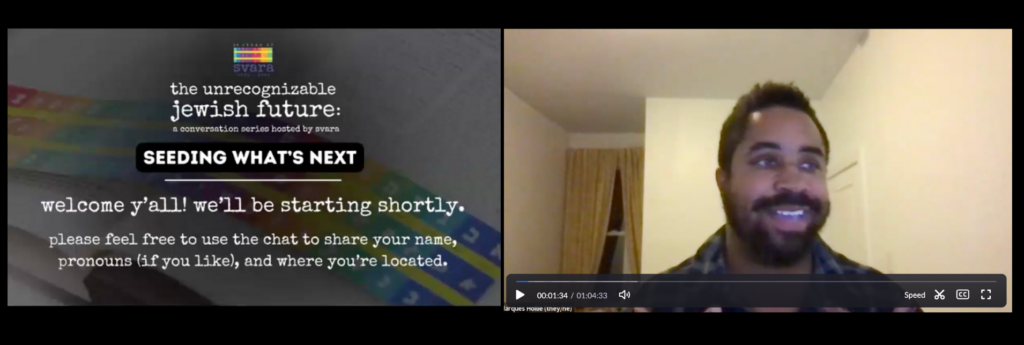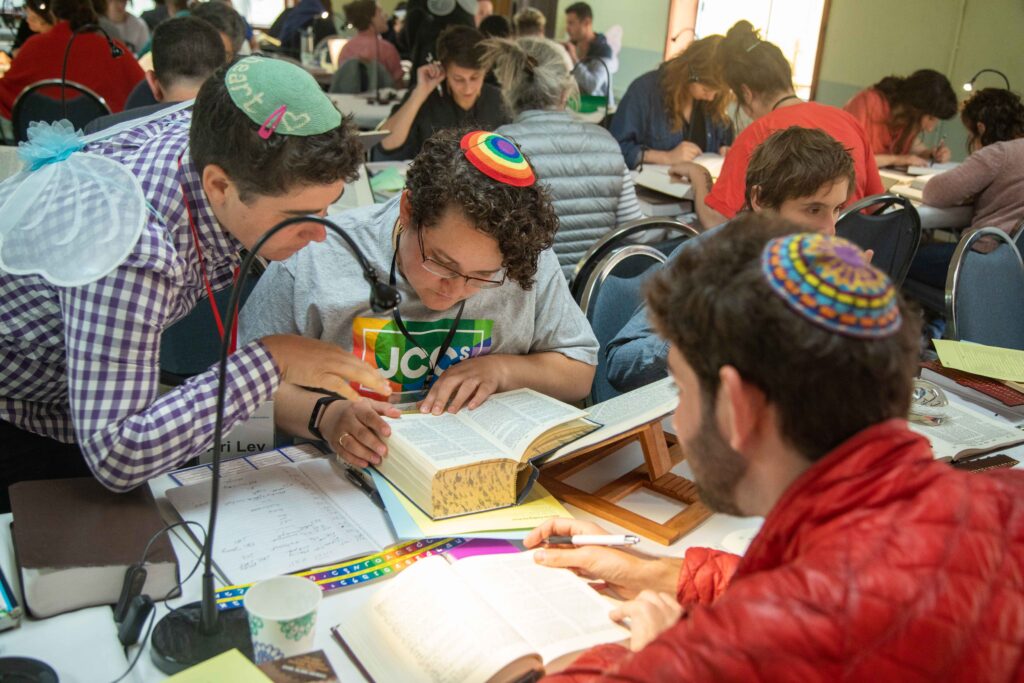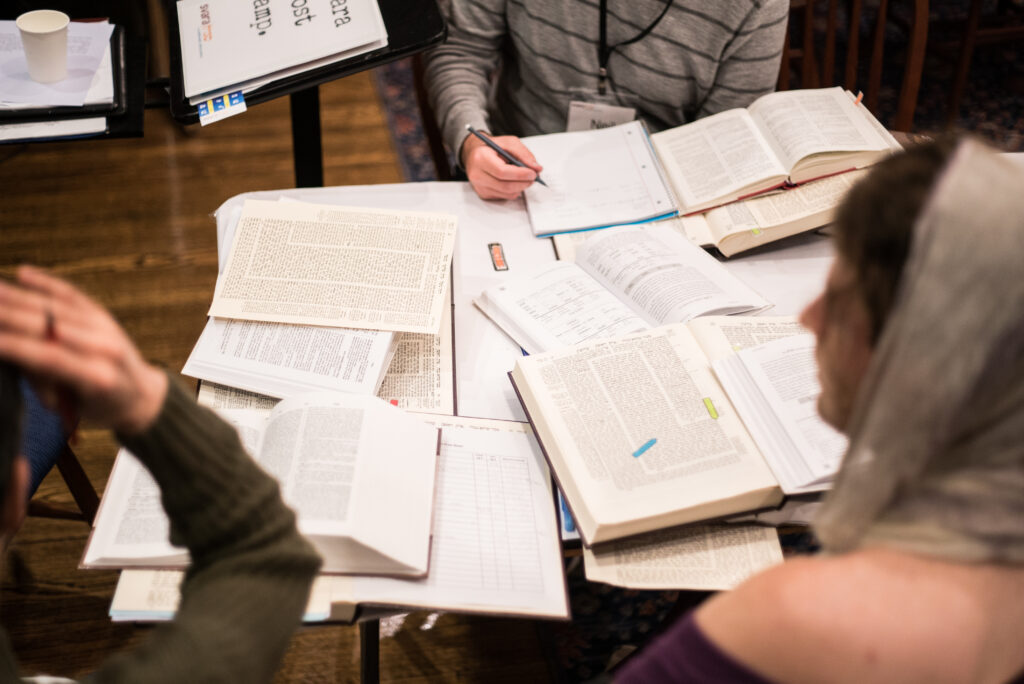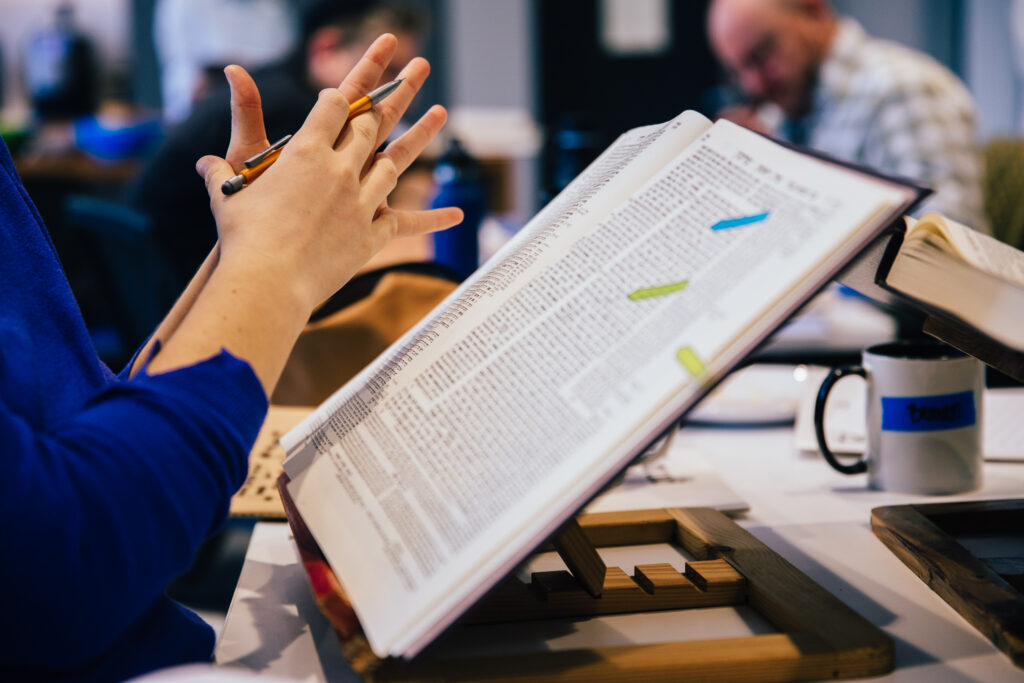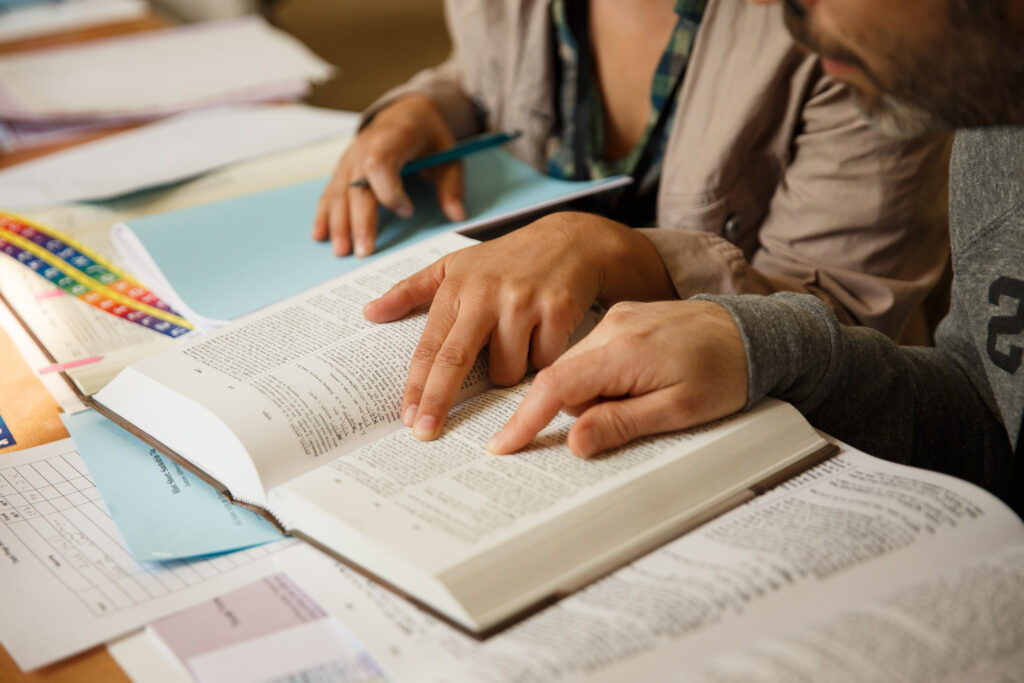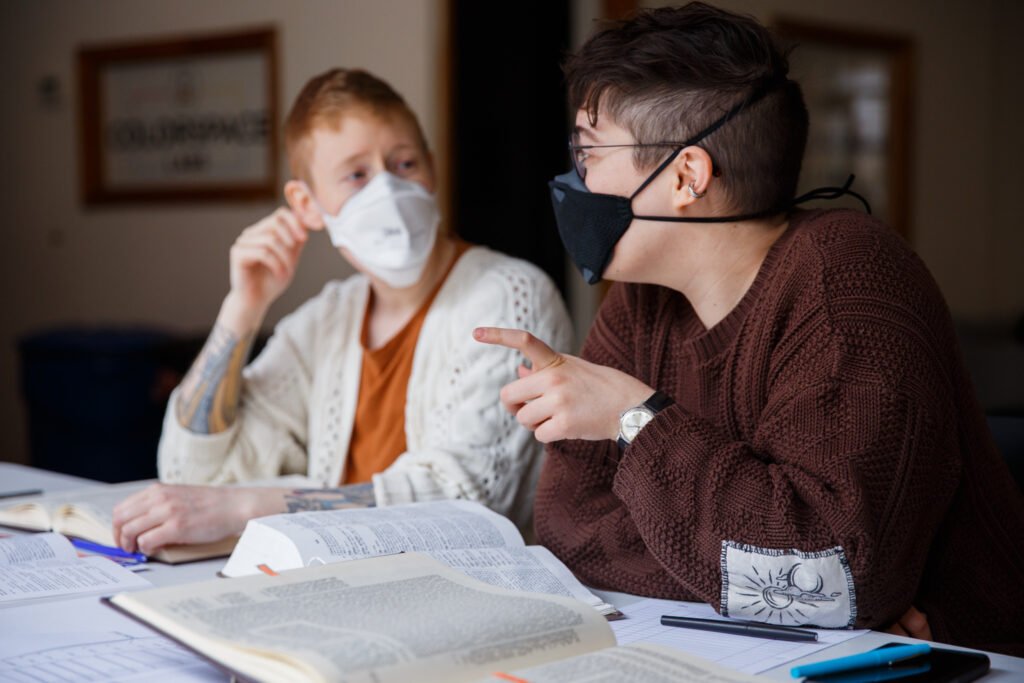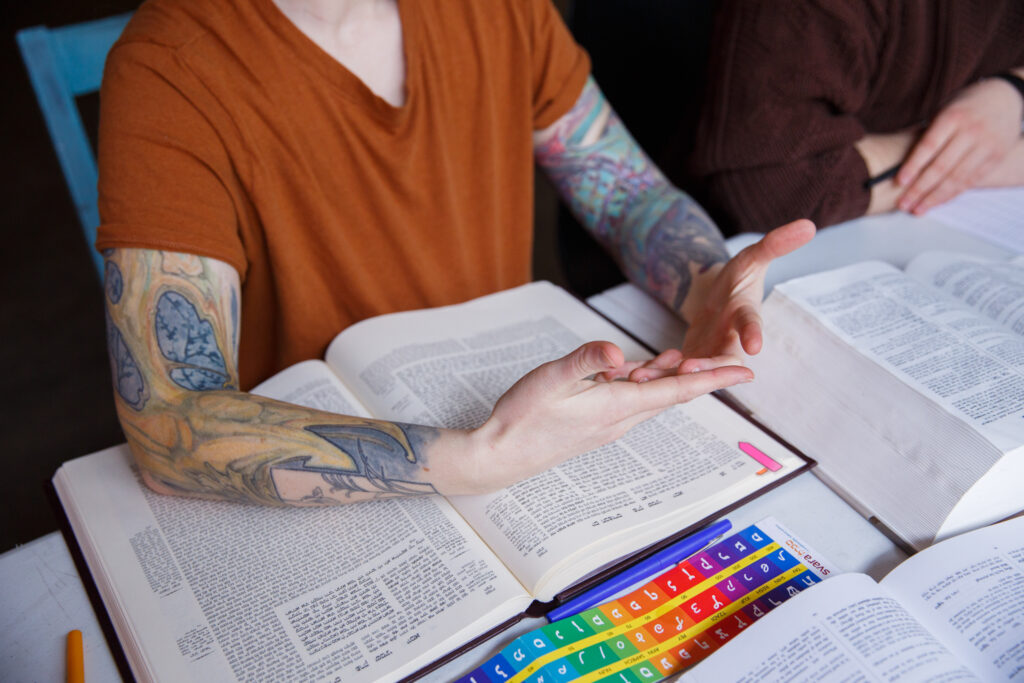For the last month, we’ve been captivated by the speakers who shared their time and their torah during The Unrecognizable Jewish Future, a four-part conversation series with leading teachers, learners, and thinkers. We learned SO MUCH from Rabbi Jill Hammer PhD, Joy Ladin, Rabbi Benay Lappe, Shahanna McKinney-Baldon, Dr. Koach Baruch Frazier, Rabbi Mónica Gomery, and Rabbi Elliot Kukla. We are forever grateful for our incredible host, Maggid Marques Hollie, as well as the techs, captioners, ASL interpreters, and the behind-the-scenes team who helped make it all a reality. We are especially grateful for y’all, the 500+ folks who registered and showed up with unmatched curiosity, care, and commentary. As we close out this series, we are holding unimaginable gratitude for the wisdom of SVARA Fellows Rabbi Xava de Cordova, noa ilana, Emet, and Chava Shapiro, all of whom joined us this past week for our final conversation.
MARQUES HOLLIE: Jewish practice and tradition have been evolving in response to moments of CRASH throughout history. What change have you seen in Jewish practice, community, or tradition over the past 10+ years that has brought you the most hope?
CHAVA SHAPIRO: When I think about the last 10 years, there are so many different things that have happened Jewishly in different worlds that intersect with the rest of the world, and so many of them have been resonant for me. One I have noticed is a powerful revival of the Jewish left – and I mean a far radical left and an overtly Jewish presence within that. What has seemed markedly different to me about past iterations of Jewish participation in the far radical left movement, both here and globally, is the presence of a full Jewishness, whatever that looks like. I see people exploring what it means to be a part of social, political movements while bringing our fullest Jewishness into it with us. One example that comes to mind is the Stop Cop City movement, which has involved an occupation of forested lands slated to be taken over by a police training project. One of the resistance efforts of that movement was that people built a sukka in the forest. I found that one small act so unbelievably inspiring. Within these radical movements I’m seeing a Jewish showing up, and a Jewish inviting in, which really has become a ritual that includes folks far beyond who is considered Jewish. I find it endlessly inspiring that Jewish ritual can offer meaning-making for a lot of people with different experiences right now.
XAVA DE CORDOVA: I really appreciate what you shared, Chava. I think it connects to what I was thinking about in trying to answer this question, which is that I started reconnecting with Judaism as an adult, and when I started that process I felt like I was trying to plug myself into normative Jewish community. But over the past 10 years there have been so many projects and communities and spaces founded by folks on the margins. These are projects that are centered around that marginality. I think this has created a much more varied ecosystem that breaks down and redefines this tendency to funnel all of our resources into one kind of Jewish institution. I’m finding it so encouraging because I believe it’s helping to make the Jewish future that much more sustainable, and that much more representative of who we are. There is such a deep need for projects like these to be supported because it impacts which version of the unrecognizable Jewish future gets decided, and I think it’s nice to see more folks in the running.
EMET: Something hopeful I’m noticing is a loosening and a softening about what counts as Jewish ritual, and Jewish tradition, and Jewish practice. This loosening is inviting more people into Judaism. To use SVARA language, it invites them to feel ownership of the tradition. I’m thinking about my first synagogue job, which was at a shul that did not say the word “God,” on purpose. That was a part of their project, and that feels like it would have been really unrecognizable a decade ago. I think that softening and loosening of boundaries is really opening the door for some beautiful blossomings.
noa: Building off of that, I’m seeing a lot of radical permission that’s happening. People giving permission to themselves—and folks giving permission to each other—to decentralize rabbinic Judaism in some ways. To reconnect and re-learn, or un-learn, previous versions of Judaism. This involves the act of re-incorporating things that get often relegated to the category of quote “women’s ritual” and craftwork and other things that have always necessarily been an integral part of Jewish tradition. I’m seeing those aspects of Judaisim getting a lot more space in ritual, in protest, and in day to day life.
MARQUES: How are you drawing from Jewish tradition in your current practice?
EMET: In true SVARA-nik fashion, I care a lot about knowing why things mean what they mean. As a convert to Judaism, I felt like there was initially more of an emphasis on learning the “what” as opposed to the “why,” but as someone who is also pretty traditionally observant, it became very clear to me that if I didn’t understand why I was doing what I was doing, I could be left behind. Luckily I was surrounded by people who would not have let that happen to me, but I never wanted anyone else to feel left behind. A lot of the work that I do is making Jewish traditions incredibly accessible. It’s a lot of translating liturgy into zines, into weird little essays that I write, into weird little collage art and children’s curriculum. I think Jewish tradition inspires me in my current practice because it reminds me that the tradition is so deep and there’s so much meaning that I’m trying to figure out and trying to uncover. And because of that, the rituals that I begin to sort of piece together and build for myself and others get to be deep.
XAVA: Emet, I’m really glad to hear you talk about your work in creating new rituals, specifically because I am so ritual insecure. I’m a very text-based Jew (laughs). And I have worked on embracing that I am just not as great at facilitating or creating ritual as I am at studying or teaching text. For that reason, getting to be with you in this conversation helps me feel one of the things I was thinking about in response to this question. A big element of my Jewish practice is the sense that Judaism is an inherently collective endeavor, and that idea nourishes all aspects of my life. The way I choose to think of it is we all make sure the mitzvahs get done together, rather than each of us doing every mitzvah. I really feel that on this panel and I also feel it more broadly in this room. That other people around me are carrying the pieces that I’m not able to carry. The fact that our tradition allows for me to feel like I am a little piece of the multi-millennia project of Judaism is a huge source of strength for me.
CHAVA: One of the things that first really got into my heart when I first started learning with SVARA was the feeling that I got to enter the chat with my ancestors (laughs). It was the experience of feeling present in the conversation, and it made me start to think about how else I can engage my ancestors, especially those who maybe didn’t have the opportunity to write down their notes on the conversation. I’ve been particularly grateful for being introduced to the work of Kohenet Annie Cohen and her reclamation of the ancestral tradition of keywermessen, or the measuring of graves or cemeteries. This has become an incredibly meaningful practice to me. I live in the U.S. Mexico borderlands in the Sonoran Desert and part of this landscape is the earliest Jewish cemetery in what’s called Arizona, which predates statehood. This Jewish cemetery sits just a few yards from a visible border wall in Douglas, Arizona and this practice of tending these graves has been important for me in that place. I’ve written a short zine on it and a short film as well. This practice has allowed me to engage with my ancestors in multiple ways. And these are not people i’m related to but rather these are people I’m Jewishly connected to, who have no living relatives, so there’s no one to tend to their graves. And what’s more is that it allows me to confront their presence on this land, which is a part of settler colonialism that caused and still causes deep wounds. It allows me to be in conversation with my ancestors. When we choose to engage our ancestors through the daf, or in ritual, or in ancestral practices, it means we get to bring our ancestors along toward this unrecognizable Jewish future. I believe that there’s room for our ancestors to be there, however flawed they might be. Learning Talmud with our flawed rabbinic ancestors gave me compassion for all of our flawed ancestors, and that’s something i’m holding closely in practice.
noa: I think part of living Jewishly in these unrecognizable ways involves paying close attention to what things can mean in the day-to-day. Yes, it’s important to think about ritual, and liturgy, and Talmud, but it’s also important to look at what it means to be incorporating ritual in how we eat and share food together, whether or not that is keeping kosher. What does it mean to teach in Jewish ways? What does it mean to raise children in Jewish ways, what does it mean to engage with our elders in Jewish ways. What’s our real life, day-to-day? If you lose something, what’s the segulah for that. If someone is sick, what does it look like to send out prayers for that person? How do we teach each other ways to do this? I think that is a practice that has been part of our tradition for a long time, and being able to pull them out not only when we’re actively gathered in prayer but in the rest of our day-to-day is a big part of what I’m aiming for right now.

